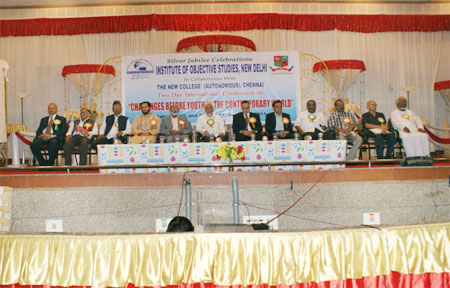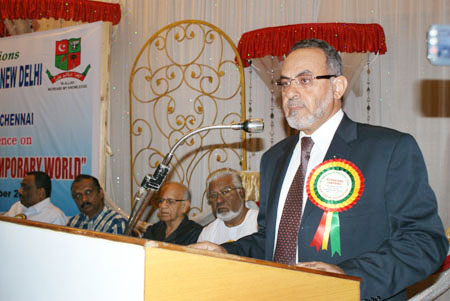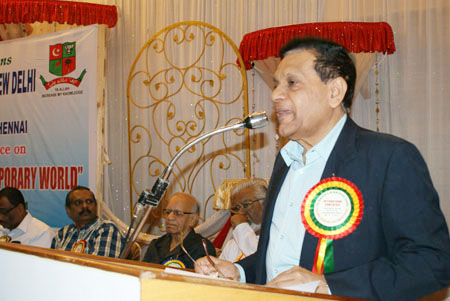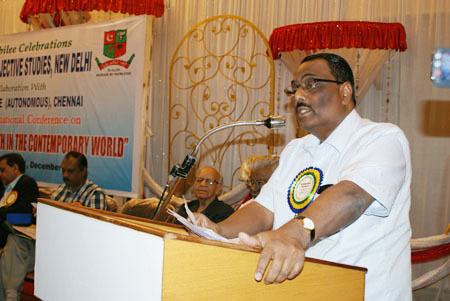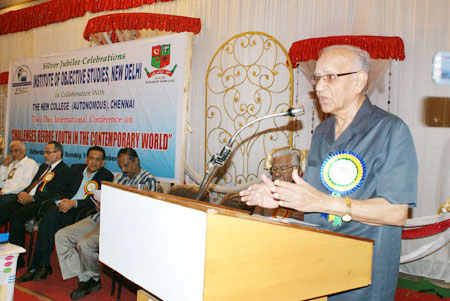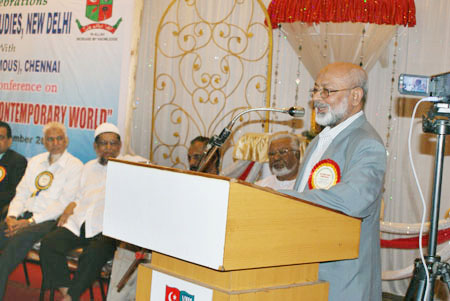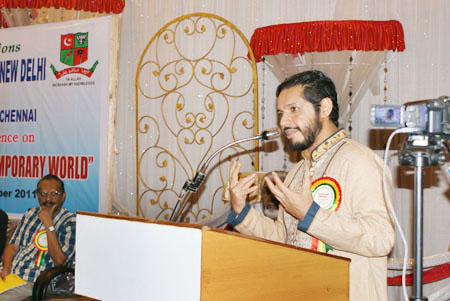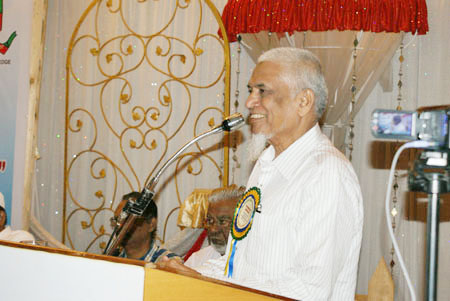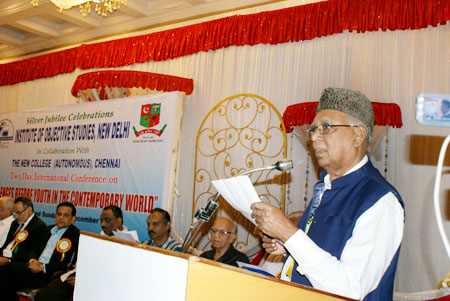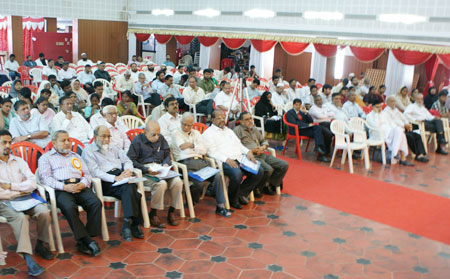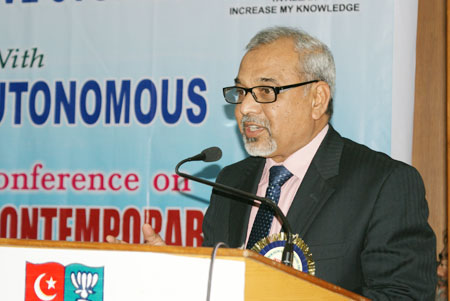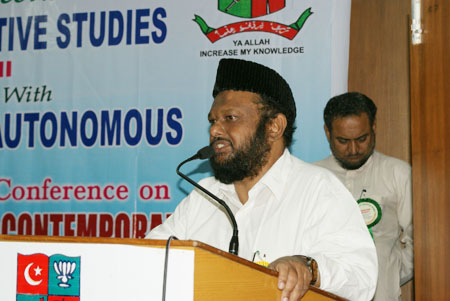India has an intense nationalism, is a greatest country on earth! India is multi cultural, pluralistic Nation. She has to arrive in economic, agriculture, social, educational, health and hygiene next to China. But, in reality corruption, religious chauvinism, pseudo politics, ignored minorities, industries employing not even one percent of the population is disturbing. Amity India strives to expose India’s anti secularist force , being detrimental to India’s progress and to the social justice.
Wednesday, February 29, 2012
Wednesday, February 22, 2012
The Right of Children to Free and Compulsory Education Act, 2009: Some Reflections
February 21, 2012
Frontline cover story: A decade of shame
| |||||
| COVER STORY A decade of shame in Ahmedabad
 GULBERG SOCIETY IN Ahmedabad today. Sixty-nine people died in the arson and massacre at the Society in the 2002 anti-Muslim pogrom SAIRABEN SANDHI and Rupa Mody sit quietly on the back benches at the Metropolitan Magistrate's Court in Ahmedabad watching the proceedings in the Zakia Jafri case. Both the women have witnessed immense tragedy. One saw her son killed, while the other has been searching for her missing son for the past 10 years. In the courtroom, there are others too who survived the gruesome massacre at Gulberg Society in Ahmedabad in 2002. All of them have gone through the trauma of seeing immediate family members hacked or burnt to death. The judge eventually postpones the hearing to another day and the survivors file out. They seem used to this routine. There is a level of tension and disappointment among them, but they are not entirely disheartened. “We come for every hearing in this case. Until we are alive we are not going to give up. We are not going to leave him [Chief Minister Narendra Modi]. We know we will get justice even if it takes another 10 years,” says Rupa Mody. The Zakia Jafri case has begun to symbolise the struggle for justice for all the riot victims and is reaching a crucial stage. It is the only case in which Modi is named as an accused and is, therefore, seen as critical in nailing the perpetrators of the pogrom. Coincidently, as the tenth anniversary of the Gujarat riots approaches, the case has taken a significant turn. The Special Investigation Team (SIT) has filed a “closure report” saying there is not enough evidence to prosecute Modi. Zakia Jafri's legal team has gone in appeal. Its main contention is that the riots were meticulously planned and those in seats of power deliberately turned a blind eye to the attacks on Muslims across the State. In the past few years, Modi has tried hard to get rid of the taint of the riots and get what he calls a “clean chit”. However, each time the “clean chit” has been within grasp, the law has intervened to thwart him. With Assembly elections in Gujarat scheduled for later this year and national politics beckoning him as an aspirant for the prime ministership, Modi appears desperate to get the riots-responsible label off his back. Furthermore, he has worked the corporate sector to project himself as a forward-thinking leader who is interested in bringing prosperity and development to his State – and not as a saffron politician interested only in communal politics. Getting the Tatas to shift their Nano small car plant to Sanand from Singur in West Bengal was clearly a part of this agenda, say observers. February 28, 2012, will mark a decade since the Gujarat riots, undoubtedly one of the worst chapters of communal violence in the country's history. Official estimates put the death toll, of both Hindus and Muslims, at a little over 1,000, while unofficially it has been pegged at more than 2,000. At least 600 children were orphaned and more than 400 were reported missing. Ten years later, the wounds are still to heal. The investigation into the riot cases are plodding along with no closure in sight. The only case to reach a conclusion is Sardarpura, where a mob burnt alive 33 Muslims trapped in a house. Thirty-one people were imprisoned for life in this case. There are eight other cases that are pending trial. For many victims the memories of the violence are still fresh in their minds. “Only justice will help heal. But nothing they do can bring back my son,” says Rupa Mody. If the nightmares of the 2002 violence were not bad enough, the minority communities have had to cope with severe marginalisation. Thousands of families have been hounded out of the State, and they have moved with just the clothes on their back to areas such as Mumbra in Maharashtra. On issues relating to the minority community, the dominant view is that over the past decade Gujarat has become more polarised than ever before. Access to education, employment, housing and other fundamental needs is becoming increasingly difficult. What is worse is that there are few rays of optimism – there is only a sense of helplessness. Zakia Jafri, a big hope Zakia Jafri saw her husband, Ehsan Jafri, a former Member of Parliament, being hacked to death. Ehsan Jafri thought that his house in Gulberg Society offered the best protection to other residents of the locality from the rampaging mobs. Unfortunately, in spite of several phone calls to the police and senior politicians, help never arrived and Jafri had to handle the mob single-handedly. Eventually, he stepped out of his house in an attempt to placate the mob. They killed him and then burnt his body in front of his family and neighbours.  Of the 30 homes and approximately 20 families, only one family continues to inhabit what is now virtually a ghost colony. Zakia Jafri remembers vividly every moment of those two horrific days. As many as 69 people died in Gulberg Society and 28 went missing, one of them was Azhar, Rupa Mody's 13-year-old son. To date they remain missing. Zakia Jafri, along with several activists and members of the Citizens of Justice and Peace (CJP), a non-governmental organisation, has maintained that the Gujarat riots were a pogrom and that there is enough evidence to prove this. Leading a protracted legal fight for justice for the past eight years, the feisty 70-year-old says she will not back down until the perpetrators and killers of her husband and thousands of other Muslims are punished. “Now, at this stage, we won't let them close the case so easily. We will keep it going for however long it takes to get justice,” says Zakia Jafri, who lives with her son in Surat. “You cannot say that in 10 years nothing has happened. Modi's name is linked to terrible communal riots. His name is badnaamed (sullied) all over the world. Everyone knows his true colours since this case has got so much attention. The fact that he has blood on his hands… he cannot wipe that off so easily,” she said to Frontline. Zakia Jafri's case reached a critical juncture in February, when the SIT decided to file a “closure report” citing lack of prosecutable evidence against Modi. Zakia Jafri's legal recourse is to appeal for the report. On February 15, she was told the report would be given within a month. This could mean the end of her case but she does have the provision to appeal in the higher courts and eventually in the Supreme Court. In 2006, Zakia Jafri petitioned the court alleging that Modi and 61 others, including politicians, policemen and bureaucrats, had colluded to ensure that the victims of the mob attacks during the riots did not receive help. Zakia Jafri, along with other witnesses, testified in court that Ehsan Jafri repeatedly called Modi when they were under attack. But no help came. She accused Modi of abdicating his duty as the constitutionally elected head of the State government to protect the right to life of all its citizens regardless of their caste, community and gender and becoming the architect of a criminal conspiracy. In 2007, the Gujarat High Court rejected her petition for a first information report (FIR) to be filed. Zakia Jafri and the CJP then filed a special leave petition (SLP) in the Supreme Court, which appointed Prashant Bhushan amicus curiae. In 2009, the court appointed a Special Investigation Team led by R.K. Raghavan, former Director of the Central Bureau of Investigation (CBI), to probe the Zakia Jafri case. In 2010, Zakia Jafri and thousands of others saw some manner of justice when the SIT summoned Modi for questioning. This was the first time in the country's history that a Chief Minister was questioned in a criminal complaint that dealt with communal violence. But two years later the SIT in its report cited lack of substantial evidence to prosecute him. In an interview to Frontline, at that time she said: “Yes. It has been a long time. But when I heard Modi had been summoned, I said, ‘ Insaf ho jayega' [Justice will happen]. Someone like Modi cannot be accused of such a major crime without adequate evidence. We have persevered at collecting every relevant detail to implicate him. One day it will pay off. If he admits his guilt, that itself would be a punishment for someone like him.”  In what seemed like a victory for both parties, in September 2011 the Supreme Court sent the Zakia Jafri case back to the trial court in Ahmedabad as it chose not to pass judgment on whether Modi should be prosecuted or not. Modi celebrated the order, saying this essentially let him off the hook. Zakia Jafri and Teesta Setalvad, activist and lawyer with the CJP, too, welcomed the order and saw it as a move in the right direction. “This is part of the judicial process and we welcome and respect the Supreme Court's directive. It has not, by any length, given Modi a clean chit. They are just following the correct procedures,” said Teesta Setalvad. “Of course, we couldn't expect the Supreme Court to make a major decision, but this is as good. The reason why it is a victory for us and not for Modi or the BJP is that it has gone past the FIR stage,” she said.  This February the SIT, however, took what is now being seen as a predictable step and filed a “closure report”. Activists and those involved in the case exploded at the move. Sanjiv Bhatt, a suspended police officer who was named as a witness by Zakia Jafri and who testified against Modi, said: “In spite of substantial direct evidence and overwhelming circumstantial evidence to establish Modi's complicity in the anti-Muslim pogrom of 2002, the SIT says they do not have enough to prosecute him.” He added: “The SIT has deliberately suppressed and concealed data which would implicate Modi.” In 2010, Raju Ramachandran was appointed amicus curiae as Prashant Bhushan stepped down. Informed sources say Ramachandran's report is damning and flies in the face of the SIT's “closure report”. The next few weeks will determine where this case goes, says Teesta Setalvad. “But we will pursue it relentlessly. The Zakia Jafri case has become a symbol of justice and we have to keep it going.” Gulberg Society – A mother's story Rupa (Tanaz) Mody, her husband Dara Mody, and two children were the only non-Muslims living in Gulberg Society. Her son Azhar has been missing since February 28, 2002. Until she sees his body, she says she will not be convinced he is dead. He is among the 28 persons missing from this colony, which was ravaged by a mob that set it on fire by throwing chemical-filled vials that burst into flames once they hit a surface. Eyes brimming with tears, she says she has searched for Azhar for 10 years and will continue searching for him. The family has gone through every morgue in the city, every police station, and put up posters too. A film, Parzania, has been made on her son. They have done whatever it takes to locate a missing person, but there is absolutely no sign of the boy. Distraught and angry, she says: “I will fight until my dying day to see that Modi and his band of rogues are nailed. I was in Jafri Saheb's house and saw how our cries for help were ignored by Modi and the police. I want them to pay.” On the eve of the Zakia Jafri closure report case, Rupa Mody spoke to Frontline about what happened at Gulberg Society 10 years ago. Her story is only one of many horrific incidents that took place during the pogrom. She summoned the courage to speak out where others could not: “My children were at tuition when we heard of the train burning in Godhra. The TV was on in my house but I didn't pay much attention to it at that time. My husband, who is a film projectionist, called from his office to say there were reports of violence and we should be careful. I got the children home. Then we began to see our neighbours come out looking concerned. Ours was a small enclosed colony of houses and from my flat I could see people gathering on nearby terraces. That is when I saw one man holding a gupti [axe] pointing towards us – then I became concerned.  CHIEF MINISTER NARENDRA MODI speaking at a BJP rally near Ahmedabad on September 25, 2011. “We started gathering in Jafri Saheb's house. He was an MP and we were sure he would organise help. Suddenly there were hundreds of men scaling the walls and entering the Society. They had hundreds of little vials of chemicals – resembling nail polish bottles, which they threw into our house. As soon as they hit a surface they would explode in flames. The mob had cleverly cut the water supply from the overhead tanks ,so we had no way of putting out the fires. They began gheraoing Jafri Saheb's house and demanding that he come out. We were 30-40 of us hiding, and we tried to hide the gas cylinders so that the chemicals would not hit them. They were using the cylinders to blast walls. Meanwhile, outside, our neighbours were being butchered by the mob. We could hear women shrieking – later I was told many were raped. “By the evening almost every room was on fire. There was a ladder leading to the terrace at the back of the house. We started climbing towards that escape. By then many people had fallen unconscious because of the smoke. I could hear Jafri Saheb say, ‘Let me die if it saves you.' That was the last line we heard from him. He was killed by the mob. At this point I had both my children with me. In the commotion, I fell. “As I fell I could hear my daughter shout: mummy get up, mummy get up. My daughter had been holding my son Azhar's hand right through the time we were hiding in Jafri Saheb's house. She had to let go of it to save me. When I managed to get up I only saw my daughter Binaifer not Azhar. We kept shouting Azhu! Azhu!, but could not find him. We finally made it up to the terrace, but even there we couldn't find Azhar. I tried going back down but everyone told me the mob would kill me. Still Zakiaben said, ‘Let her go – she is a mother.' Finally, when help came, we were told a boy matching Azhar's description was at the Saibagh police station. I rushed into the police station shouting ‘Azhu! Azhu!' but it wasn't him. I haven't stopped searching since then. “We went back to Gulberg Society almost two weeks later. The entire colony had been burnt down. Ironically, my house was untouched. Perhaps because I had a picture of Mata on the wall they thought it was a Hindu house. Sometimes I wonder if I hadn't left my house we would have been safe and I would still have Azhar.” Rupa Mody says Zakia Jafri's case is very critical to all the riot cases. This case names Modi as the prime accused. She says everyone in Gujarat will agree that Modi controls everything, and this violence could not have taken place without his consent and knowledge. “What do you tell a mother who cannot find her child?” says Father Cedric Prakash, who heads Prashant, a human rights organisation in Ahmedabad. “Modi won't allow Parzania to be screened in Ahmedabad. Why? What is he afraid of?” A ghost colony Located in Meghaninagar, a suburb of Ahmedabad, Gulberg Society is a tiny colony of half a dozen houses and 18 apartments. To understand how cruel and violent the riots were, one has to walk through the Society compound today. The houses are burnt shells. Walls are broken and covered with soot from the fires started by the mob. There are no windows on any of the houses, and the ones that remain are either shattered or have fallen. The floors are covered with mud and ash. Here and there are burnt remnants of household materials – a painting, some slippers. It is an eerie feeling when one wonders how many dead bodies would have been found on these floors. Zakia Jafri-Citizens for Justice and Peace case - a chronology (PDF) Gulberg's compound is filled with weeds, overgrown foliage, garbage and stagnant water. Stray dogs have made it their home, and one can see a few passers-by stopping to ease themselves on the walls of what was once someone's home. A watchman from the nearby bakery is allowed to use one of the rooms of a bombed-out home, to sleep during the day. When awake he keeps an eye on the property. The property cannot be sold or developed as it is under litigation, testimony to a terrible crime and a numbing reminder to those who survived. Of the 30 homes and approximately 20 families, only one family continues to inhabit what is now virtually a ghost colony. Kasimbhai Alanoor Mansoori lost 12 family members, including his wife, daughter and a son. Occupying the first house, he says he does not live here anymore but uses the premises for business. “We built these houses with so much difficulty. The houses must be worth a least Rs.50 lakh. But that doesn't matter. We have lost so much more,” says Mansoori. “The Gulberg Society case is very important because of Modi's involvement. We have to keep fighting,” he says. Every year on February 28, members of Gulberg Society gather in the compound and pay homage to those who were killed. This year will be no different. It can only be hoped that the Zakia Jafri case moves in the right direction. Anything other than that would be unfair to those who have lost so much. |
Posted by
c-info
at
Tuesday, February 21, 2012
Labels:
Gujarat 2002 riots,
Justice,
victims
Subscribe to:
Posts (Atom)
